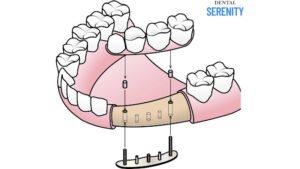Transosteal Implants
Transosteal implants are a type of dental implant designed to provide a stable and long-lasting solution for patients with severe bone loss in the jaw. These implants are typically used when there is insufficient bone mass to support traditional endosteal implants, which are placed directly into the jawbone. Transosteal implants, on the other hand, are placed through the jawbone, extending from the outside to the inside of the jaw to provide anchorage for dental restorations.
The main advantage of transosteal implants is their ability to be used in patients who have experienced significant bone loss due to conditions such as periodontal disease, trauma, or congenital defects. Traditional implants may not be viable in these cases because they rely on the presence of sufficient bone volume for stability. However, transosteal implants provide an alternative solution by utilizing a more extensive anchoring system.
These implants consist of a metal post that passes through the jawbone, providing support to the dental restoration. The process typically involves two phases: the initial placement of the implant and the subsequent attachment of the prosthetic tooth or teeth. The first phase of the procedure involves inserting the transosteal implant into the jawbone through a surgical incision. The implant is designed to extend through the bone and protrude from the outside of the jaw to provide secure anchorage for the restoration. This procedure often requires general anesthesia or sedation to ensure patient comfort during the surgery.
Following the initial placement of the implant, the area is given time to heal and the bone begins to fuse with the implant through a process called osseointegration. This process typically takes several months and is crucial for the long-term success of the implant. Once osseointegration is complete, the dentist or oral surgeon will attach the prosthetic tooth or teeth to the implant. The result is a durable and functional replacement for the missing teeth.
The transosteal implant procedure is particularly beneficial for patients who have undergone previous tooth extractions or suffered from severe bone resorption. In such cases, the bone may be too thin or weak to support conventional dental implants, but transosteal implants provide a means of achieving stability and functionality. Moreover, transosteal implants can offer a solution for individuals who are not candidates for bone grafting procedures, as they do not rely on the augmentation of bone tissue.
Despite the benefits, there are some challenges and risks associated with transosteal implants. The procedure is more invasive than traditional dental implants due to the need for a larger surgical incision and the complexity of placing the implant through the jawbone. As a result, the recovery time may be longer and more uncomfortable for the patient. Additionally, because transosteal implants are inserted through the bone, there is a slightly higher risk of complications such as infection or implant failure.
Another consideration when using transosteal implants is the potential for aesthetic concerns. Since the implant passes through the bone and extends outside of the jaw, it may be visible in some cases, depending on the placement and type of restoration. In such instances, patients may be concerned about the cosmetic appearance of the implant and the surrounding area.
While transosteal implants are not as commonly used as other types of dental implants, they remain a viable option for certain patients, particularly those with significant bone loss. Advances in implant technology and surgical techniques continue to improve the success rates and outcomes for patients undergoing transosteal implant procedures. For individuals with severe bone loss or other complex dental needs, transosteal implants offer a reliable and effective solution for restoring both function and aesthetics.
In conclusion, transosteal implants represent a significant advancement in dental implant technology. They provide a valuable option for patients with severe bone loss who may not be candidates for traditional dental implants. Although the procedure is more invasive and carries certain risks, it can offer a long-lasting and stable solution for individuals seeking to restore their missing teeth. As with any surgical procedure, it is important for patients to carefully discuss their options with a qualified dental professional to determine the best treatment approach based on their individual needs and circumstances.

